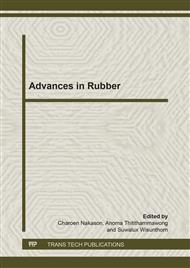p.101
p.105
p.109
p.113
p.117
p.122
p.127
p.131
p.135
Processing of Thermoplastic Vulcanizates Using High Speed Intermeshing-Typed Internal Mixer: Influence of Mixing Patterns
Abstract:
Thermoplastic vulcanizates (TPVs) were produced by high speed intermeshing-type internal mixer. TPVs based on Ethylene-propylene-diene rubber (EPDM) and polypropylene (PP) with peroxide crosslink system, were used in this investigation. TPVs were prepared by different processing condition using the same TPV recipes. In this study we focus on the effect of mixing pattern on TPVs properties. From the results, tensile properties and hardness of TPVs are slightly affected by processing conditions. In the same way, compression set which relate to crosslink density in rubber phase, were not affected by processing condition as well. All TPV samples were extruded to form a strip of 1 x 50 mm rectangular cross section using single screw extruder. It was found that, the stage of adding curative shows significant influence on extrudates surface of TPVs. TPV samples produced by adding the curative at low temperature show the smoothest surface. This is because the fine dispersion of crosslinked rubber phase which confirmed by AFM.
Info:
Periodical:
Pages:
117-121
Citation:
Online since:
November 2013
Price:
Сopyright:
© 2014 Trans Tech Publications Ltd. All Rights Reserved
Share:
Citation:


